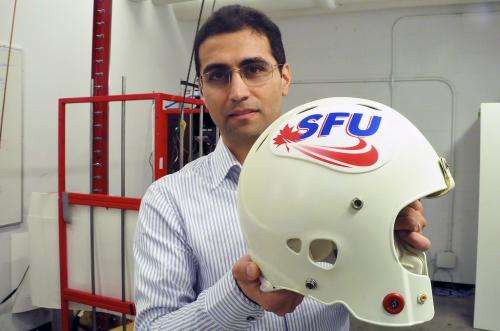Increasing helmet safety with impact-diverting 'patch'

A team of researchers at Simon Fraser University's Surrey campus has developed an impact-diverting "patch" (IDP) aimed at increasing the safety of helmets by mitigating the potential for head injuries. The patent-pending technology is currently completing a preliminary field trial with the assistance of the SFU Clan's football team.
"In a collision situation, safety helmets nearly always contact the ground or other object barriers at an angle, causing both compression and swift rotation of the head," says Iman Ebrahimi, a post-doctoral fellow in the School of Mechatronics Systems Engineering (MSE) who has supervised the technology's development.
"While research studies show that the brain tissues are considerably more sensitive to rotation than compression, the majority of helmets are only designed to protect the head against compression of the brain."
The IDP addresses the issue of rotatory motion. It's the result of four years of research and development in SFU Surrey's Head Injury Prevention Lab, where Ebrahimi has conducted a myriad of impact tests using a specialized test rig under the leadership of MSE director Farid Golnaraghi, professor Gary Wang, and Combiz Jelveh, CTO of Innovata Labs, an industry collaborator.
"The results of these extensive oblique impact tests show that the IDP can significantly mitigate the risk of head injury and concussion caused by the rotary movement of the head," says Ebrahimi.
The IDP, a first-of-its-kind micro-engineered layer, can be applied to the outer shell of any helmet like a decal or a sticker. "The design consists of a 'sandwich' of materials less than 2 mm thick and weighing around 20 grams," Ebrahimi explains.
It works by disengaging the helmet's outer shell from the frictional force of the impacting surface, resulting in significantly reduced rotation of the head.
The IDP can be applied to any helmet to enhance its safety and is weatherproof and sustainable in harsh weather. An earlier prototype was found to attenuate rotary motion during a standard oblique test by more than 50 per cent, thus, reducing the force inflicted on the brain to a safer level.
The IDP is currently in its final testing phase. The SFU Innovation Office expects it to become available in 2014.
















